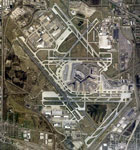Green Specs:
– LEED Silver air-traffic-control tower
– 230,000 ft2 of green roof
– Aeroponic garden for airport eateries
– Onsite apiary
– Gravel and soil reuse
There are considerable challenges to being green, if you are an airport. You are gigantic. You run 24 hours a day, seven days a week. You consume vast amounts of energy. And if you want to encourage sustainable practices, you have innumerable stakeholders that need to get on board: airlines like Delta, cargo shipping companies like FedEx, rental car companies like Enterprise, and concessionaires like Starbucks.
“We have thousands of stakeholders that all conduct business on a day-to-day basis that certainly have impacts on and opportunities to improve their sustainability,” says Amy Malick, deputy commissioner of sustainability for the Chicago Department of Aviation (CDA). “So coordinating with that range of stakeholders is really critical, and it’s also fairly challenging, just because there are so many of them.”
If you are an airport, you are also owned by the government, which has its citizens—all eight million of Chicago’s metro area, in this case—to answer to. So anything green happening at O’Hare International Airport or Midway Airport can’t be just one-third of the triple bottom line, the now-common phrase coined by John Elkington in the ’90s and repeated often today by CDA commissioner Rosemarie Andolino.
An example of CDA’s effort toward a triple bottom line is its approach to ground construction. In the beginning stages of the ongoing O’Hare Modernization Program, during which a new 7,500-foot runway was constructed, a new air traffic control tower built, and another runway extended by 3,000 feet, almost half a million tons (and counting) of asphalt and concrete were reclaimed. Instead of hauling away scrap pavement and bringing in virgin material for the new projects, “we sorted it and stockpiled it,” Andolino says. “We brought a crusher on-site and crushed the aggregate … and then used it back into the job.”

Reusing excavated soil for a recent runway project saved O’Hare money, kept about 70,000 tons of CO2 out of the atmosphere, and helped decrease local traffic.
Excavated soil, too, is kept on-site for reuse. This saves money (bottom line number one). It keeps about 70,000 tons of carbon-dioxide emissions out of the atmosphere from trucks that would have otherwise carted waste and virgin materials to and from O’Hare (that’s two). And it avoids creating traffic jams and annoying nearby communities (three).
But it’s more than the bottom line, tripled or not. “As government I believe we have to be leaders,” Andolino says. “We have to be out there pushing.” That means green roofs. It means getting alternative fuel stations and solar fields to O’Hare (the CDA has sent out requests for proposals for both). It means writing a document for best environmental practices, called the Sustainable Airport Manual, that is 690 pages long and growing, addressing not only typical LEED modules like energy and atmosphere but also how to operate greener in-terminal shops and hold a green administrative meeting. And it means hosting an annual conference called Airports Going Green to continue exploration of new technology, designs, and ideas.
If you are an airport, you have a legitimate eco-handicap, but change is possible—Chicago is proof of that.
The Details: ORD

The North Air Traffic Control Tower at O’Hare is the first LEED Silver-certified control tower in the United States. During construction 80 percent of waste was diverted from landfills. Almost half the building materials were sourced locally.
The eco-tower
The North Air Traffic Control Tower has a green roof on its base building and ultra low-flow lavatories that reduce water use by 21 percent. That’s about 700,000 gallons, annually. The structure, designed by AECOM subsidiary DMJM Illinois, is the first air-traffic-control tower in the country to receive LEED Silver certification.
The bee apiary
One and a half million bees live on the east side of O’Hare’s roughly 7,000-acre property. The apiary is a collaborative project with the North Lawndale Employment Network, which provides job training for ex-offenders in Chicago. The harvested honey is included in a line of products called Beeline and is sold online and in boutiques and Whole Foods around the Chicago area.
The giant green roofs
There are 11 green roofs at O’Hare, totaling about 230,000 square feet of vegetation. The FedEx Main Sort Building, with a roof the size of three and a half football fields, boasts the largest vegetated roof at any airport in the United States. While green roofs are more costly up front, “you’re getting a longer life expectancy,” Andolino says.
The aeroponic garden
An aeroponic garden by Tower Garden fills the G Concourse in Terminal 3 with the scent of basil, cilantro, and other herbs, lettuces and vegetables. Airport restaurants that share in the harvest include Tortas Frontera, Wicker Park Seafood & Sushi, Blackhawks Restaurant, and Stefani’s Tuscany Café.

